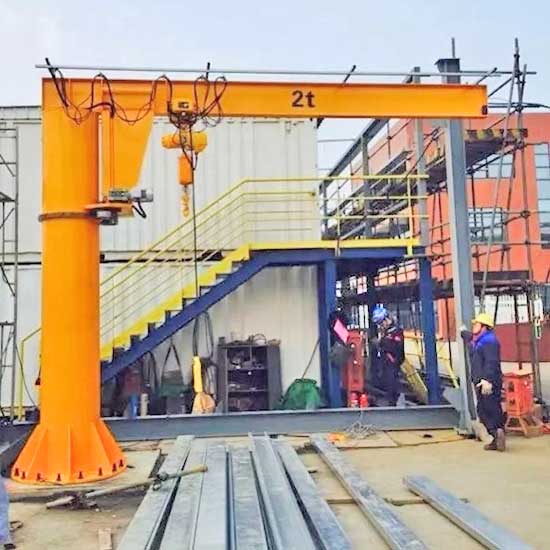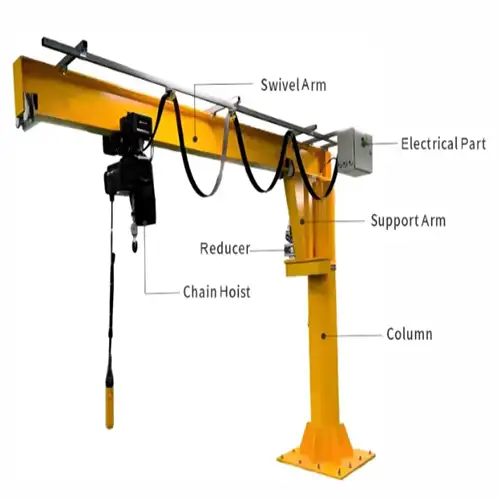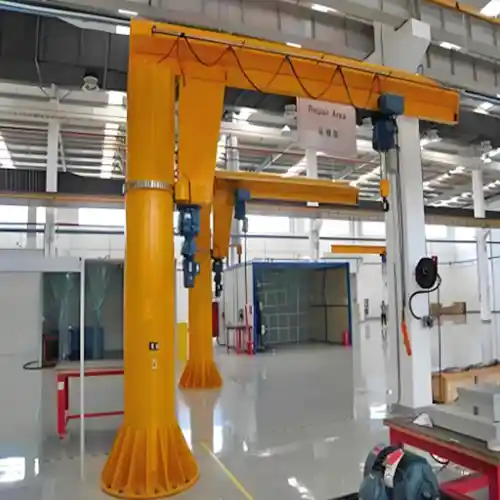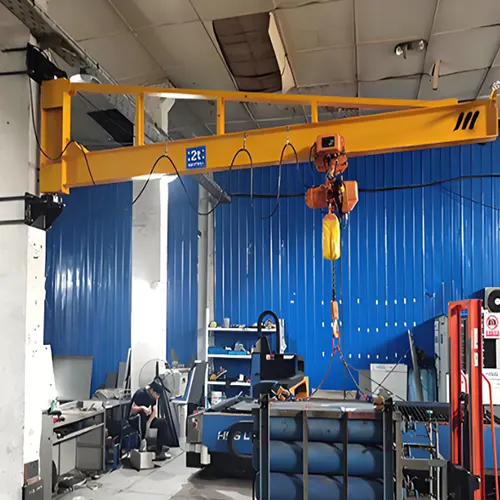Jib Crane Uses: Main Types of Jib Cranes & Jib Uses
What are uses of jib cranes? Types of jib cranes for various industrial uses,i.e, workstation, warehouse, general manufacturing, shipping & construction.
Category: Overhead Crane for Your Use
What are uses of jib cranes? Types of jib cranes for various industrial uses,i.e, workstation, warehouse, general manufacturing, shipping & construction.
Jib cranes are typically used to handle lighter loads and have smaller duty cycles than bridge and gantry cranes. A floor mounted jib cranes can work with a number of jibs at separate workstations, which can help the overhead crane to lift and handle loads to improve efficiency of whole production line. The hook's coverage is restricted to the length of the boom (typically a maximum of 20 ft.). The hook is attached to a boom that spins around a fixed point.
If precise locating of heavy loads, a large area of hook coverage, or frequent use of heavy loads are required, a jib crane may not be the right material handling solution.
Basics of jib cranes
- Capacities of jib cranes: 0.25 ton to 10 tons, and customized up to 16 ton & 20 ton
- Rotation of jib crane: 360 º or 180º rotation
- Way of jib rotation : Powered or manual rotation
- Complete units or cost-cutting kits
- Mounting type of jib : Systems that are baseplate, pipe, wall, or column mounted
- Advantages of jib hoist: Simpler or Less complicated design and less expensive than a bridge overhead crane or gantry crane.
- accurate spotting for light loads (e.g. a few hundred pounds or less)
Common uses of jib cranes
Individual workstations, such as machine tools, welding/fabrication stations, and even small assembly stations, are the most common uses for jib cranes. They're also commonly applied in simple loading and unloading procedures where precision load positioning isn't required.
- Widely used in workstations, storage, the yard, and other fixed or designated working place, etc.
- Jib cranes are ideal for short-distance or serried material handling, such as transporting loads from one work cell to another.
- For material handling, jib hoists can be utilized to supplement a large overhead crane.
- Hoisting jibs can be used as suspension of tools
- Jib cranes can also be employed for cost-effective outdoor applications.
- Jib cranes for sale are not permitted to be used in hazardous settings, such as those that are flammable, explosive, or corrosive.
Main types of jib cranes and their typical uses
Jib crane is a new generation of light-duty hoisting equipment made to adapt to modern production. Jib cranes are designed to reduce and simplify repeated lifting operations while also reducing the amount of manual work required. It is especially suitable for short-distance, frequent use and intensive hoisting operations, usually quipped with high-reliability electric chain hoists.
Jib cranes come in a variety of styles and designs , allowing them to be tailored to any need of lifting or load-bearing application. The small jib is featured as small floor coverage area, easy to operate and maintain.Jib cranes are one of the most versatile and low-cost high-capacity hoisting and material handling equipment on the market.
Pillar jib crane
Pillar jib crane, also known as column-mounted jib crane or free standing jib cranes , has a lifting capacity of 125Kg-5000Kg. Special jib hoisting equipment can be designed and customized according to customer needs. It is the most commonly used jib crane.
The pillar jib crane has the advantages of novel structure, reasonable, simple, convenient operation, flexible rotation and large working space. Lifting and transporting heavy objects in lower work and warehouses, wharfs and other occasions.
The floor mounted jib crane are widely used in factory, production lines, assembly line, loading and unloading on the machine tool, and material handling in warehouses and parts, etc.
Mobile jib crane
The mobile and portable jib crane is more flexible and adaptable. It is a necessary separate emergency hoisting equipment for efficient automatic production lines. With jib cranes , it can ensure the smooth flow of the production line. The product has the characteristics of flexibility, wide adaptability, etc., and the lifting weight is 125KG to 500KG.
Wall jib crane & Wall bracket jib crane
Wall jib crane is also called wall crane and wall bracket jib crane,the lifting weight is 125KG to 3000KG. The lifting height is 3 meters.
Wall traveling jib crane
Wall traveling jib crane, also known as wall traveling crane, is a new type of material lifting equipment developed on the basis of wall column jib crane. The running rail of the wall jib is installed on the cement column of the factory building, and can move longitudinally along the rail, and the electric hoist can also complete the lateral movement along the selection arm and the vertical lifting. The wall travelling jib cranes greatly expands the scope of operation and can utilize the workshop space more effectively. The lifting weight of the wall travelling jib is 1000KG to 5000KG, and the lifting height can be customized by customers.
Portable Jib Cranes
This new types of portable jib crane avoids the requirement for expensive site preparation and footing costs associated with traditional floor mount jib cranes. The configuration of this jib allows easy movable around the work floor. This means it can be used for a variety of uses or places. It can be used on your facility's upper floors before being stored out of the way. Standard design capabilities of porable jib crane is 250, 500, and 1,000 kg.
Articulating Jib Crane
The articulating jib crane, also known as folding arm jib crane, has the characteristics of novel structure, flexible extension, flexible operation, high efficiency and energy saving. During operation, press the button to hoist the load, and use the bending and rotating motion of the arm beam to avoid objects in the control work area to maximize the work area. Gently push and pull with your hand to reach any position in the work area. The crank arm crane is suitable for production or maintenance occasions in machinery manufacturing, railway, chemical industry, light industry and other industries, especially in the production line with dense equipment, short-distance hoisting, and frequent operations, the application of the articulating jib crane can improve production efficiency. The lifting weight is 125KG to 500KG.
Double-arm jib crane
Double arm jib crane is also known as double-arm crane, double-jib crane. The jib crane is a new product developed which can be designed according to the needs of users. It has the advantages of novel structure, reasonable, simple, convenient operation, flexible rotation, large working space, etc. It is an energy-saving and efficient material hoisting equipment.
It can be widely used in factories and mines, workshop production lines, assembly lines, and heavy objects lifting in warehouses, docks and other occasions.
Jib cranes used in different industrial applications
Because of their capacity to hoist awkward heavy loads and put them into position with high presion, jib cranes have a variety of applications and purposes. Manufacturers are constantly developing and refining new applications for these adaptable and reliable hoisting equipment.
Jib Cranes in Manufacturing
Jib cranes play an important role in the assembly process. They're installed in the manufacturing workshop to streamline the manufacturing procedures for material handling and transport, and they're put up at workstations to assist workers with assembly activities. Jib cranes have been a huge help in terms of decreasing staff stress and increasing productivity. Because of the convenience of jib crane operation, supplies can be easily available, allowing work to be completed faster and more efficiently.
Jib cranes are used to transport components from one assembly point to another in production lines where massive pieces of equipment are being assembled. The easy operation of jib crane makes load handling and transferring quick and effortless.

KBK jib crane used in worksation

Pillar jib crane for general manufacturing

Electric chain hoist jib crane for workcells
Cranes for Shipping
Material handling cranes have long been used in the shipping industry to load and unload ships and trucks. Jib cranes can easily load and unload vessels, as well as transport cargo off the dock or load them onto trucks.

Pillar jib cranes for boat handling

Electric wire rope hoist jib for outdoor application

Slewing jib cranes for factory workshop material handling
Construction Industry
The construction sector is continually confronted with the difficulty of getting larger loads into difficult-to-reach regions. Underground foundations and multi-story buildings are examples of these circumstances. Jib cranes' particular capabilities enable them to shift and arrange stacks of items into these difficult-to-reach areas, reducing manual labor and increasing efficiency.

Floor mounted jib cranes for construction site

Rotationg jib crane for outdoor use

Jib crane for outdoor material loading and unloading
Warehousing and Supply Storage
Gantry and overhead cranes, which can move the full length of a complex and lift massive loads, are prevalent in warehouses and supply storage facilities. In such activities, heavy-duty and powerful cranes are required since they improve material handling efficiency and speed. Jib cranes are utilized as supplements and add-ons to larger and more robust cranes in many warehouses. They offer the precision and accuracy required for loading items onto vehicles or onto a production line.

Free standing jib cranes for warehouse

Jib crane for round steel handling

Customized jib crane for efficient load handling
Safe uses of jib cranes
Jib cranes are used to hoist and transport heavy objects, and because they are commonly used in lifting operations across a variety of industries, you should be aware of the basic safety requirements that will help you utilize the hoisting equipment safely and efficiently. While we all know that your crane manufacturer normally provide a copy of the safety manual at the time of equipment installation, you might want to review the fast safety advice to ensure that you follow the fundamental safety requirements and prevent problems that could endanger lives.
First and foremost, you should hire professionals to install your jib cranes. This is the effective way to confirm that the equipment is properly installed and that the foundation can support the load's weight.The most crucial thing is that it has been thoroughly tested and certified prior to usage. Jib cranes should be inspected before being put into service, and you should look for things like trash on the runway, structural problems, missing or loosened fasteners, and cracked welds. You should also inspect the jib's arm for smooth movement. By positioning the jib arm directly over the load and close to the weight's center of gravity, you can ensure a solid lift.
Ensure that the beam trolley does not collide with the runway end stops, as this could cause the weight to swing out, increasing the radial span and disrupting the overall balance. Conduct a trial lift to assess the lift's stability while ensuring that the slewing arm passes along an obstacle-free path. To reduce the chances of swinging, all movements should be carried out slowly and steadily. Make sure the jib arm cantilever isn't dragging things across the floor and that a ladder isn't blocking the jib arm.
Make sure no one is allowed to walk under the loaded jib crane when the lifting process begins. With health and safety at the forefront of your mind, you may want to have your jib cranes professionally examined by qualified professionals at least once a year, as required by law.
Simply contact one of our helpful sales representatives for further information and advice on the use of Jib Cranes. They will be pleased to advise you and provide prices for any supply, installation, or testing/inspecting requirements you may have.
Get your custom jib cranes for your application & uses
The installation of a jib crane, or a series of jib cranes, can effectively improve your production, workplace safety and at same time reduce workplace injuries. Jib cranes are well-suited to high-volume lifts and offer an ergonomic way to move items within a work cell or in conjunction with an existing overhead crane system.
To ensure that you build the most cost-effective and productive jib crane system for your application and use, keep the following factors in mind:
- Duty Cycle/ Working Class: Selection of the appropriate duty cycle or working class ensures that the components are durable enough to withstand the load and usage requirements.
- Area of rotation: Freestanding and mast-style jib cranes can rotate 360 degrees, but wall-mounted cranes can only rotate 180 degrees.
- The height under boom is the distance between the floor and the underside of the jib crane's boom. Consider the size of the hoist and the required lifting height.
- Overall jib height: Consider any attachments, such as electrical entrance, when calculating the overall jib crane height so that the crane is not obstructed from above.
- Working (or hook) distance: The working (or hook) distance is approximately the length of the boom minus 1/2 trolley length at each end.
- Power requirements: Will your jib crane's motor drive, trolley, or hoist require power, or all three? Is the power source going to be electric or air? Is it better to enter from the bottom or the top? To utilize it indoors or outside?
Related Products

Latest project
150 Ton Overhead Crane Installation Feedback – Paraguay Case
QDX 150 ton overhead crane in action in Paraguay. Installation photos, video, and client feedback show performance, safety, and heavy-lifting efficiency.
Free consultation to Confirm Parameters & Specifications and Get
Latest Crane Price & Crane Rate.
- Types of overhead cranes : _______?
- Optional: Overhead travelling crane, goliath gantry crane,Slewing jib crane, Single girder or double girder crane,small portable crane or kbk crane, etc.
- Capacity of overhead crane: _______?
- Optional: 0.25ton, 0.5 ton, 1 ton, 2 ton, 3ton, 5 ton, 10 ton,15ton, 20ton, 25 ton, 30ton,35ton, up to 550ton, etc.
- Crane span & lifting height : _______?
- Crane travelling length : _____?
- Control of overhead crane:_______?
- Optional: pendant/ remote/cabin control
- Voltage supply of overhead crane:_____?
- Eg,: 380V50/60HZ,3Phase or others,etc.
- Application/usage of crane:_______?
- Eg,: Steel mill, ,injection mold, cement,stone, concrete,granite, general manufacturing, etc.
Just leave a message via the contact form and our hoist and crane engineer will contact you with in 24working hours.
Get In Touch







